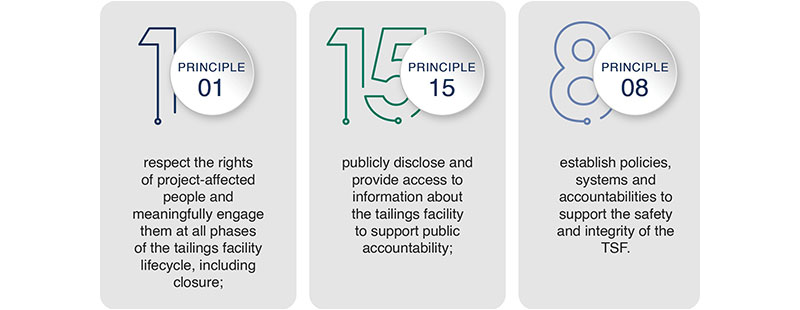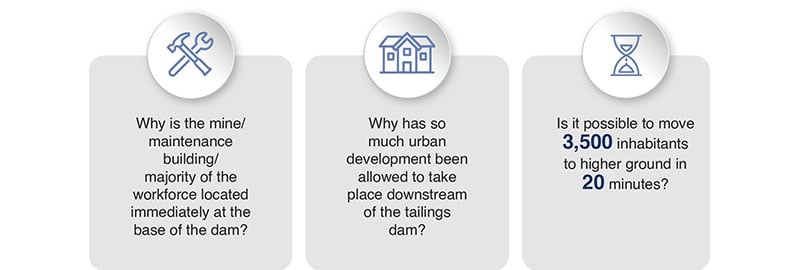Tailings dams are at last receiving the attention and focus they deserve. It is a strange paradox that, while the mining industry has made huge strides in integrating environmental and social governance (ESG) into key business decisions over the last 30 years, it has only recently started to get to grips with the risks posed by its waste disposal sites, in particular tailings storage facilities (TSFs). There is a realization that managing tailings is not just an engineering challenge, but poses a risk with significant societal consequences that puts future investment in jeopardy.
Whether this oversight is due to ‘the ostrich effect’ (the inclination to avoid unpleasant information), an overreliance on the reassurances of the engineers and auditors, or ’conceptual conservatism’ (maintaining a belief despite new information that contradicts it); it has taken two high profile dam failures in Brazil and significant investor pressure to bring this industry-wide risk to the fore.
Mining companies should be encouraged to rebalance their focus onto the non-technical aspects of TSF risks and the need to fully understand the social, human, environmental and reputational consequences of dam failures.
Not just a technical challenge
Minimizing the risk of tailings dam failures is one of the greatest challenges facing the sector. Despite the billions of dollars being invested and the recent launch of a global industry standard on tailings management, there is a concern that the industry is destined to do ‘too little too late’ to prevent further catastrophic incidents. A further 19 incidents are predicted in the next 10 years (typically there are 2–5 major failures and 35 minor failures every year) according to the 2019 world mine tailings failures study (WMTF 2019).
The technical and engineering causes of tailings dam failures have been well researched. Slope instability, overtopping and foundation stability were identified in a study by Bowker and Chambers (2017) as the three most common causes of the largest dam failures over the last 100 years. Unfortunately, the organizational and human or ‘adaptive’ causes have not been so well researched and yet these have been just as significant in contributing to catastrophic failures.
ERM reviewed the dam failure incident reports of 11 major dam failures that have occurred in the last 12 years. We concluded that basic organizational and human factors, such as budgeting, operational leadership, safety & risk culture, and competence, played a significant role in each.
The insidious nature of the risk posed by an ageing or closed tailings dam often results in the risk becoming normalized, especially to those working at the site and the communities living downstream of it. Several well-known psychological risk responses converge, including the ‘ostrich effect’ (let’s not go there) and conceptual conservatism (you won’t change my mind); often to such an extent that inspection and improvement actions end up getting pushed back. In some cases, the mere fact that it has been audited and the risk has been ‘plotted’ gives the false impression that a) the TSF is being managed effectively and b) the risk of failure has been reduced.
Decision-makers often rely on layers of controls that are reviewed by peers, subject matter experts and independent boards. Some of the reviews, however, do not dig deeply enough into how the controls are being implemented and how well they are understood by the workers managing the dam. Indeed, in almost all cases when a third party review is conducted of a TSF encompassing the management of controls (e.g., training, deviation reporting, corrective action tracking, communication, and governance processes), significant breakdowns emerge quite readily.
Any control strategy cannot be devoid of the human factor. Governance has a vital and powerful role to play. Those who are charged with this responsibility will typically rely on the expertise of others to report on the assessment of risk. Here the perception that a major failure may be a very low probability event is reinforced by the seemingly compelling nature of technical arguments and the low salience of the envisioned catastrophe. Those involved in governance roles should ideally have a natural preference for avoiding complacency and strong antennae for confirmation-bias and group think. It’s all too easy to take comfort from the familiar litany of reassurances around the low probability of failure.
Every individual now has a right to know the risks
A recently launched publication titled “Global Industry Standard on Tailings Management” produced by the Global Tailings Review—which was co-convened in March 2019 by the United Nations Environment Programme, Principles for Responsible Investment and International Council on Mining and Metals following the Brumadinho tailings disaster—introduces principles of “zero harm to people and the environment”. The new standard reflects a wide range of inputs from governments, investors, insurers, academics and industry professionals. Additionally, the chief executive officers from most of the major mining companies, including all International Council on Mining and Metals members, have made a public commitment to comply with the requirements of this standard within three years for very high and extreme consequence dams (Global Tailings Review 2020).
The standard includes a number of principles requiring community engagement and public disclosure as well as incorporating organizational and human factor considerations:

If implemented, the residents of nearby communities will come to know the risks and understand related emergency response plans and procedures. They will also be able to contribute to the development of high-level recovery plans, in the event of catastrophic failure.
![]()
Revealing the scale of downstream impacts
In 2019 following the Brumadinho disaster, investors (initiated by the Church of England Pensions Board and the Swedish AP Funds Council of Ethics) issued an urgent request to over 600 extractives companies asking them to provide details on the management of their tailings facilities. The request for dam-by-dam disclosure was made at the beginning of April 2019 and was supported by 100 investors with over USD $12.5 trillion in assets under management.
Publicly disclosing information is a great first step and many of the leading players (29 out of the top 50) in the industry responded to the challenge, resulting in the public disclosure of the management of thousands of individual tailings facilities on company websites. For many this disclosure has revealed some uncomfortable truths and further analysis and quantification is revealing the true scale of the problem.
Based on disclosed information on approximately 600 TSFs across the world, our analysis has shown that there are in excess of 1.3 million people currently living downstream and within 20 kilometers (km) of such TSFs, placing them well within the impact zone. Not only that, but 57 percent of these people live downstream of TSFs constructed using upstream construction methods, which is considered to be the lowest initial cost for a raised tailings embankment due to the minimal amount of initial fill material required. Half of these TSFs remain operational while a further 25 percent are recorded by the operators as simply ‘inactive’ but not closed or rehabilitated.
Our analysis has considered the location and topography of these TSFs as well as the plausible flow trajectories. Using satellite imagery, we have estimated that more than 70,000 km2 of land, (an area the size of Scotland) is at risk of impact from these tailings facilities should they fail.
Facing up to the challenge
These are material and complex issues which do not have easy or necessarily short term solutions. We are seeing a rapid and transformational change taking place amongst the world’s leading mining companies in how they view and manage the risks associated with their TSFs. A wide range of actions are being initiated (summarized below), which will help to raise understanding and awareness and diminish the risk.
Understanding the consequences of failure
Mining companies are increasingly articulating not only the likelihood of an event occurring (e.g., the risk is 10-3) but also the likely environmental and social consequences of a dam failure (e.g., number of communities impacted, people killed, livelihoods lost, and protected habitats destroyed) as well as its financial impact. Mining executives need to have this information clear in their minds—and what it really means. Risk plots, typically in the form of 5x5 matrices, do not show the full extent of the problem (especially the potential financial and reputational consequences).
A greater emphasis on risk visualization
A virtual image of the dam’s location and surrounding area accompanied by a model of the tailings that would be discharged (and speed of travel) in the event of a failure brings the ‘consequence’ conversation into sharp relief for executives and potential future investors.
Live images typically generate a meaningful discussion, which in our experience has included questions such as:

Our safety, environmental, and community specialists often find themselves confronting the phrase ‘our engineers have assured us that…’ but as the discussion shifts to management, understanding, and communication, a different picture emerges.
Non-Technical TARPs
The mining world has long used trigger action response plans (TARPs) to predict and prevent potential engineering failures. Governance TARPs, with triggers to take action when a breakdown in a system occurs (e.g., training, deviation reporting, corrective action tracking, communication, and governance processes) are largely absent. A breakdown in systems or governance must have the same significance and trigger the same reaction as a breakdown in an engineering control (e.g. escalated to the board). A balanced and integrated approach that places the same level of scrutiny on the non-technical aspects of tailings management is needed.
Boards and other governing bodies must summon the courage to challenge when presented with perpetual claims that ‘all is well’. This includes provision of more evidence on the reliability, and daring to talk explicitly about the magnitude of the consequences that will result from failure to act. No control measure is ever constant and many engineered solutions degrade over time. Management teams get re-organized with ever increasing frequency and what was a focus for one leader may be back of mind for their successor.
A better dialogue with regulators and communities
These are extremely complex problems to resolve and some of them have been gradually simmering away for decades. Legacy and ill-suited dam designs, encroaching communities not constrained by local and regional planning authorities, and in some cases an ‘engineering-only’ led approach, have contributed to the current situation. In the highest risk locations, informed and honest consultation and joint action with public authorities will be necessary over decades.
Conclusion
An over-reliance on engineering standards and considerations has led to a focus on the low likelihood of tailings dam failures—yet they continue to occur. As companies move to implement the new standard, this will require a widening of perspectives from dam stability alone to embrace the so-called “nontechnical” aspects of risk (e.g., the human and social factors). Forming a deeper understanding around the consequences of failure will assist in having better dialogue with affected peoples. This shift in focus will translate into material improvements in TSF risk management, which will in turn protect value, maintain the ability to operate, and serve as a needed catalyst for long-term change in the sector.
References
WMTF (World Mine Tailings Failures). 2019. World Mine Tailings Failures—from 1915— supporting global research in tailings failure root cause, loss prevention and trend analysis.
Bowker, L. and D. Chambers. 2017. “In the Dark Shadow of the Supercycle Tailings Failure Risk & Public Liability Reach All Time Highs.” Environments, 4(4), p.75.
Global Tailings Review. 2020. Global Industry Standard on Tailings Management. August 2020. Co-convened by the International Council on Mining and Metals (ICMM), United Nations Environment Programme (UNEP) and Principles for Responsible Investment (PRI). Available online at: https://globaltailingsreview.org/wp-content/uploads/2020/08/global-industry-standard_EN.pdf. Accessed October 2020.
The Church of England. 2019. Thousands of Tailings Dams Revealed for the First Time as Over 200 Companies Disclose. 17 June 2019. Available online at: https://www.churchofengland.org/more/media-centre/news/finance-news/thousands-tailings-dams-revealed-first-time-over-200-companies. Accessed October 2020.

